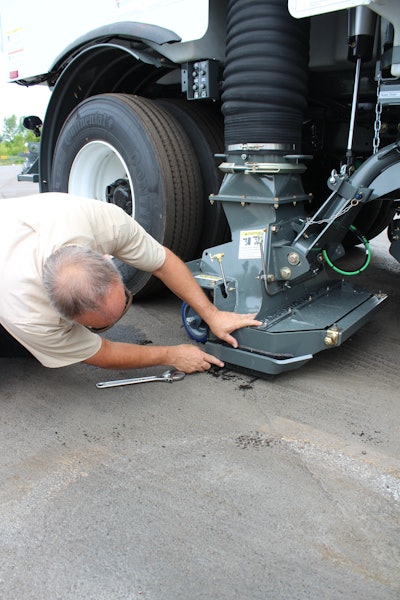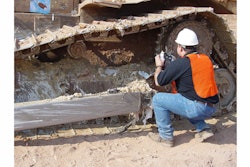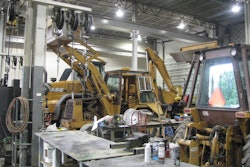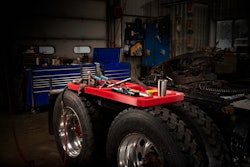
Wear parts on sweepers are viewed by most contractors simply as an annoying cost. But as manufacturers point out, those wear parts are designed to both improve the quality of the sweep and to protect the unit. So proper management of wear parts involves monitoring, maintenance and timely replacement.
“Many of these parts are basically sacrificial. They’re designed to be replaced,” says Jim Adair, director of product management, Schwarze Industries. “When set up and used correctly and monitored with a regular maintenance program, most sweeper wear parts will be able to last their expected life or even longer.”
So you have to allow the wear parts to work for you. These parts are designed to assume the abuse and to protect other more costly or more complex parts. Steve Dunning, technical training instructor, Elgin Sweeper, says to get the most value out of wear parts contractors need to replace them at the appropriate time. “By trying to save a few dollars by delaying replacement of a wear part, you might be causing damage to another, larger or more expensive part that you will have to replace,” Dunning says
Main and Gutter Brooms
Main brooms move debris from the pavement to the conveyor or elevator where it is then carried to the hopper. Dunning says that when new, main broom bristles are 12-13 in. long. Most sweeper manuals contain guidelines on what amount of broom wear is acceptable, but Dunning says that for optimal flicking action, Elgin Sweeper recommends main broom replacement at about 6.5 in. long – about the length of a dollar bill.
“Once the bristles on the main brooms of mechanical sweepers wear to half their original length, the ability to flex properly and ‘flick’ debris is greatly reduced,” Dunning says. “A worn broom can cause trailing of debris, carry-over, and multiple passes in order to clean the surface.”
He says gutter brooms have two jobs – cleaning the gutter and moving the debris in front of the main broom. “Again, the length of a dollar bill is a helpful measurement tool to determine when it’s time to replace these side brooms – about 6.5 inches,” Dunning says. “If these brooms are too far out, they won’t put the debris in front of the main broom, and you’ll see a trail of debris. Assuring the gutter brooms are depositing the debris in front of the main broom is essential.”
Setting Broom Pressure
“Down pressure of the brooms can greatly affect sweeping,” Dunning says. “Too much down pressure can cause the brooms to “mop” the surface (basically pushing debris around), reducing flicking action and negatively affecting sweep quality. As a rule of thumb, Elgin Sweeper recommends setting the down pressure to the lowest setting that still effectively picks up debris.
But broom pressure will need to vary depending on the work environment – sweeping millings vs. sweeping a parking lot, for example – so broom pressure needs to change too. “Setting the tensioning properly will enable you to get the longest life out of your bristles,” Adair says.
It used to be that operators had to climb in and out of the cab to determine proper broom pressure, but today’s in-cab pneumatics make it easier for the operator to adjust the broom pressure – even on the fly. That not only makes it more likely the operator will keep the pressure adjusted properly, it also extends broom life and improves sweeping quality.
But if your unit does not feature in-cab adjustment, Adair says the procedure to follow is:
- Lower the broom onto the pavement
- Spin the broom, then lift it up
- View the pattern the broom left on the surface
- Make adjustments accordingly
When it’s time to replace brooms, it’s important that you’ve metered them so you can compare longevity. There are many different types of main brooms -- tube brooms, strip brooms, wafer brooms, or cable-wrapped brooms -- and it’s important that you compare the same broom types.
“When buying new brooms, make sure to compare apples to apples,” Dunning says. “Material type, bristle population (the weight of the bristle material), and broom pitch (the distance between bristles) are all factors that affect broom performance and efficiency.”
Maintaining the Conveyor
The broom’s job is to flick the debris from the pavement onto the rubber belt conveyor, where it is carried into the hopper. The conveyor requires daily inspection to check for tears, damage and tracking. Any torn or damaged belts should be replaced.
“Over-tensioning will stretch the fibers on the belt and it will break prematurely,” Adair says. “Not enough tension and it will slip and also break prematurely.”
Dunning says the conveyor belt also should be centered on the rollers and track during operation. “It’s also important to ensure that the belt cleats do not hit the pan under the belt, as that will also damage the belt,” he says.
Because the conveyor’s job is to move debris, it’s important to clean them every day. And cleaning includes flushing the conveyor (and elevator) until clean.
“On conveyors, the most important place to clean is the lower roller, as that area typically holds debris,” Dunning says. “Using a 2-in. firehose with plenty of water is highly recommended. After cleaning, we also recommend running the conveyor for a while to dry it. A wet conveyor can cause sticking in some cases.”
Monitoring the Elevator
While some sweepers incorporate conveyors, others feature elevators, which involve a number of squeegee-type flights on a pair of chains that squeegee the debris up the elevator pan. “The rubber squeegees must be close enough to the pan to move debris, and that requires some adjustment, as the squeegees are prone to wear,” Dunning says. “The chains also wear and stretch, which requires routine elevator adjustment. Over-adjusting the chains may shorten the life of the elevator.”
Dunning says Elgin Sweeper specifies a certain distance the chains should sag. “When the chains are within an inch of each other in the middle, it’s time for the chain to be adjusted,” he says. “Over-tightening the chains can cause more stretching, which can shorten the life of the chain.”
Dunning says that to ensure the best efficiency moving the debris away from the main broom into the hopper, flights and chain sprockets should be replaced routinely. “Chain sprockets should be replaced before the teeth begin to ‘cup’,” he says. “Once sprockets begin to require more frequent replacement, this means the chains have stretched and also require replacement.”
Dirt shoes
On each end of the main broom are the dirt (drag) shoes, made of steel, wear-resistant alloy, carbide-filled or rubber. “The shoes contain the debris in the main broom path and must be properly adjusted so the bristles fill to the edge of the shoe. They also should be adjusted to operate level and wear uniformly. Shoes should be replaced when worn so they do not wear into their mountings,” Dunning says.
Adair, who recommends tungsten-carbide shoes, adds that proper tensioning of the shoes affects both sweeping quality and shoe longevity. “You want the carbide to seal but you don’t want the shoes to carry the full weight. Proper tensioning creates the seal but does not carry the weight,” Adair says. “That prolongs their life.”
Many contract sweepers try to extend the life of their dirt shoes by running them just a little longer than they should.
“Excessively worn or damaged dirt shoes will cause trailing and increased sweep passes for clean-up of the sweep job,” Dunning says. “Excessively worn shoes can begin to wear into the parent material of the shoe mounting or even the pickup head itself. This may cause excessive marking of, or damage to, the street surface.”
Adair adds that allowing the shoe to wear too much could result in the failure of a larger component – rather than just of a part that is designed to wear and be replaced. “If you allow the carbide on the runners to wear too much you could get into the runners themselves, and that’s a more costly replacement than just replacing the carbide wear parts,” Adair says.
“Replace and adjust the pickup head shoes before they have worn through the abrasive material in the shoe,” Dunning says. “This will ensure the best debris pickup performance, best control of blow-out, and reduce pickup head damage.”
And when replacing drag shoes, the material you choose should be determined by the sweeping environment, cost and warranty. “What tells the tale sometimes is the warranty,” Adair says. “Will they give you a one-year warranty because, if not, then you’re buying a drag shoe that’s probably not going to last a year. And if they’re not going to last a year how much money are you investing in that part?”
Curtains & Flaps
Curtains and flaps direct and control the air flow and help direct and contain debris beneath the unit. Damaged curtains on air sweepers can cause a loss of air speed, impacting the air flow; worn, damaged, or improperly adjusted curtains can cause trailing of debris or reduced pickup. So they require proper adjustment and condition.
Adair says rear flaps need to be straight down while front flaps are more flexible and should trail back to allow the debris to come underneath. He says front flaps are lighter weight and have lighter wear because there’s less tension on them against the ground. Rear flaps are stiffer and so wear more.
Adair says that the type of sweeping dictates the wear of the flaps so contractors need to make sure to monitor wear and make adjustments as necessary especially when changing sweeping surfaces.
“Streets have a bit of a crown to them so when you switch from streets to sweeping a parking lot there could be a trail behind the sweeper because of how the crown wore down the rear flap. The rear flap assumes the contour of the pavement it’s going over,” Adair says. “You need to monitor that and adjust the flap if necessary.”
Why to Use Water for more than Dust Suppression
When contractors talk of lubrication they’re almost certain to be talking grease and oil. But in the case of sweepers, at least, lubrication can mean water. And water-as-lubricant is an often overlooked aspect of sweeper operation and parts longevity.
“People often decide they don’t need water on a particular job or in a certain kind of environment, but using water is not just about the dust. When you add water everything moves easier. There’s less friction which lengthens the wear time,” Adair says.
Without water, for example, the conveyor rubs dry rubber against metal. “It’s just like windshield wipers on a car window with no rain. There’s a lot of friction and surface tension,” Adair says. “But if it stays wet it moves easily and reduces the wear on it.”
Plus, less friction means the hydraulics don’t have to work as hard, so they can last longer too.
And on an air unit water reduces the abrasion of particles on the impeller, the tubes and the hopper. Metal tubes that wear thin in spots because of the abrasive nature of the debris and the force the debris can be protected when the debris is wet.
“The hoses start wearing through and you can blow a hole in an area,” Adair says. “On intake hoses on air machines we recommend rotating them one-quarter turn every 50 hours so the air is not concentrated on one area continually. And with water in there it reduces the abrasion from the particles.”
Use Care when Replacing Bearings
Bearings are not something that’s necessarily considered a wear part, but Adair says they should be because they are usually maintained or replaced by the contractor.
“A lot of times the bearings wear out and it turns out over-lubrication is the cause,” Adair says. “Many people think more you lubricate the bearings the longer they will last. But that’s not always the case because the more grease you use the more difficult it is for the hydraulics to work because they have to work harder pushing the bearings through all that grease.”
He likened bearings working through too much grease to running in the ocean in water up to waist high. “When you’re running in water waist high it’s difficult for you to move and you have to work extra hard to make any progress,” Adair says. “But move closer to shore and run in water that’s ankle deep and running becomes easier. It takes less effort and yet your feet still stay cool.
“Too much grease results in a lot of resistance and that increases the temperature of the environment in which the bearings are working, which can shorten bearing life.”
Another problem is that when contractors work on bearings they try to push too much grease into the bearing chamber and they can purge the seals, which creates an opening where dirt can come in and damage the bearings.
He says bearings should be replaced by OEM bearings “because then you know you‘re replacing them with the same bearings you had before. An aftermarket bearing might not have the same seals or the same seal on an end piece,” Adair says. “There are some nuances we’ve learned over the years to incorporate into our designs because we want the bearings to last as long as they can.”
Establish a Regular Maintenance Program
Manufacturers stress that a regular, scheduled maintenance program is the most important factor in making sure wear parts reach or exceed their expected life. “If you’re not tracking it you don’t know if you or your operator is doing something that’s detrimental or beneficial,” Adair says. “It pays to measure and keep track of wear part use no matter whose product you use as a replacement. Otherwise you don’t know if you‘re getting any advantage out of it.”
While both Dunning and Adair recognize contractors like to experiment with aftermarket sources for replacement parts, they encourage at least checking with the sweeper manufacturer because they say, part prices are competitive.
“But if you’re switching from one wear part to another wear part and you don’t measure, you don’t know if that change in parts is giving you another 30% usage or not. Cities and contractors that do the best with their machines are the ones who measure and track the use and life of their parts. And doing it by the hour is best,” Adair says. “Then they know if there are any changes if the changes are due to the part, the operator, the type of machine, the product not standing up, or the type of work being done.”
Sweeper Maintenance Tip #1
When cleaning an air sweeper, flush the suction nozzles with water. That will help water run through the system.
Sweeper Maintenance Tip #2
Open the hopper and clean out all the debris, especially in the corners. Debris retains water, and water promotes rust, so cleaning the hopper is essential to ensuring a longer life for the sweeper.
Sweeper Maintenance Tip #3
Make sure the impeller is properly flushed by directing a stream of water into the impeller intake on the hopper, or into the intake if the hopper is raised. This will clear the impeller of any carry over that can cause imbalance, reducing impeller and bearing life.
Sweeper Maintenance Tip #4
Because of the abrasive nature of the debris and the force it’s at when it comes into contact with the suction tubes, the hoses start wearing through and hole can be created in the hose. Adair recommends rotating intake hoses one-quarter turn every 50 hours so the air is not concentrated on one area. Dunning says Elgin Sweeper recommends rotating hoses every 150 hours, alternating them between 180 degrees and 90 degrees, to even out the wear.
Sweeper Maintenance Tip #5
Don’t over-lubricate bearings. Many people think more you lubricate the bearings the longer they will last. But Jim Adair points out that the more grease you use, the harder the hydraulics have to work because they have to push the bearings through all that grease. Over-lubrication increases the temperature of the environment in which the bearings are working, which can shorten bearing life.
Sweeper Maintenance Tip #6
Use OEM parts when replacing curtains and flaps because OEM flaps come with pre-punched holes and a custom kit for a particular sweeper model will include all new nuts and bolts. Jim Adair recommends replacing all the hardware at the same time you replace any flaps because old hardware is liable to be rusted or weakened because of the abuse it’s taken.
Sweeper Maintenance Tip #7
Use proper tensioning on the springs so the sweeper head is level, not uneven. If spring tension on the head is uneven you will likely cause uneven wear on drag shoes, which will result in wear on the sweeper head. The end result is you will need to replace a larger, more expensive component – the sweeper head – than just the drag shoes.
Sweeper Maintenance Tip #8
Allow the wear parts to work for you. These parts are designed to assume the abuse and to protect other more costly or more complex parts.
Sweeper Maintenance Tip #9
Jim Adair, Schwarze Industries, says that when replacing rear flaps seek out a flap made of corded rubber which provides the greater stiffness needed for rear flaps.
Sweeper Maintenance Tip #10
Rely on water as a lubricant. “Water helps the dirt shoes move freely on the ground, and helps lubricate the debris going up through the elevator on a mechanical sweeper, or the suction hoses on an air sweeper,” says Steve Dunning, Elgin Sweeper. “Water in the debris stream is extremely important for effective dust separation in the hopper.”


















